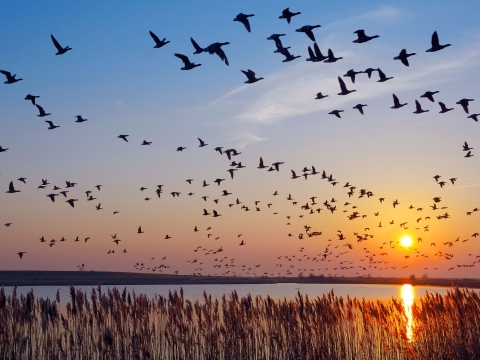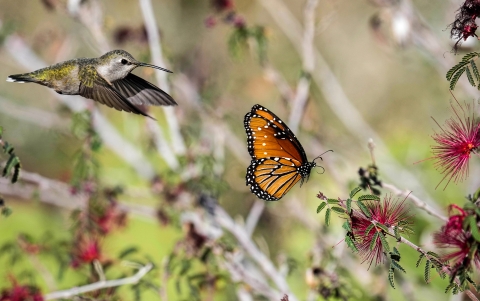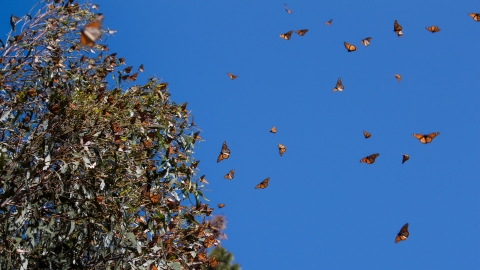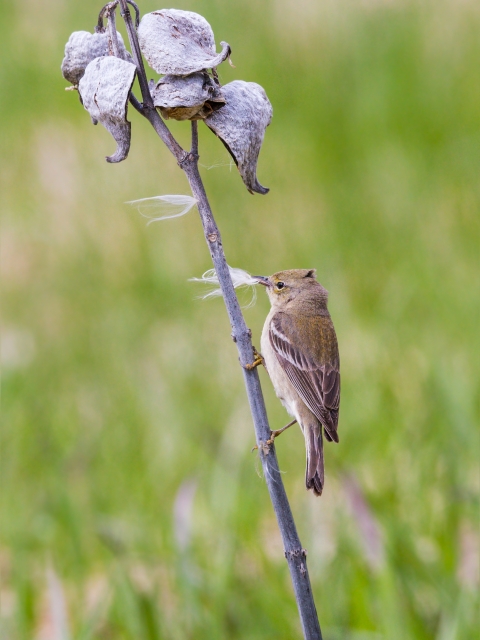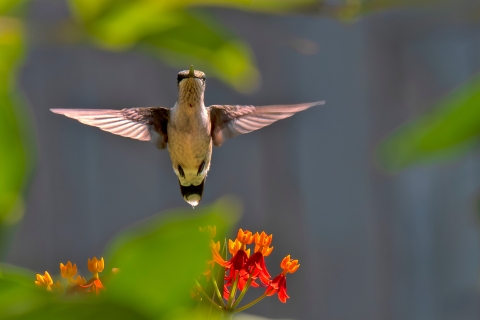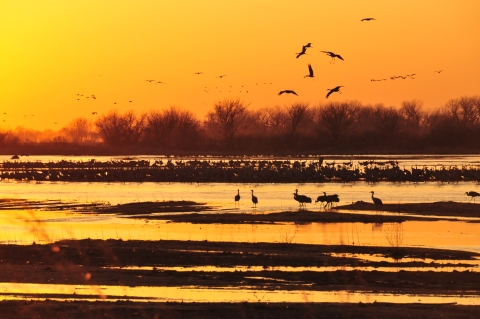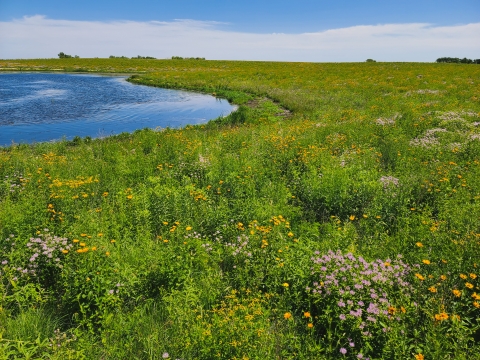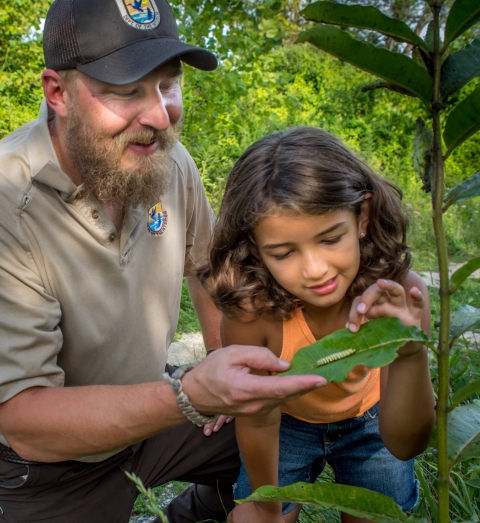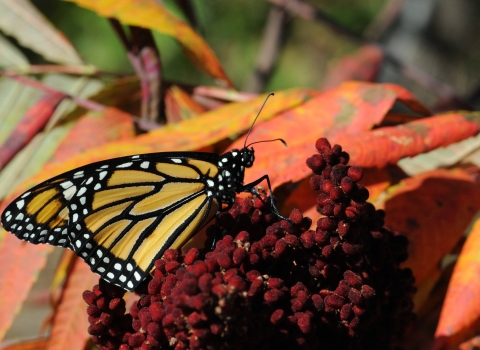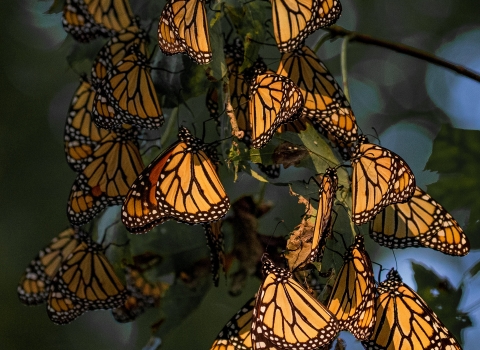As fall's cool breezes sweep across North America, the skies come alive with a remarkable spectacle—monarch butterflies and migratory birds embarking on their long journeys southward. Guided by the changing seasons, they travel vast distances in search of warmer climates where they can rest, refuel, and complete their life cycles. These awe-inspiring migrations are not only a spectacle to witness but are also essential for the survival of these species.
Monarch butterflies journey from as far north as Canada to the mountainous forests of Mexico, while neotropical migratory birds, after breeding in North America, return to their non-breeding grounds in Latin America and the Caribbean. Despite their differences in size and behavior, both monarch butterflies and birds rely on healthy habitats rich in water and native plants to sustain them along their migration routes.
This year, World Migratory Bird Day focuses on the critical relationship between birds and insects, captured by the theme “Protect Insects, Protect Birds.” Both birds and insects, like monarch butterflies, depend on biodiverse, healthy habitats for the resources they need to survive. Insects, in general, are an essential food source for many migratory bird species and can be particularly important for breeding birds who use them to feed their young. Unfortunately, studies show that insect populations are declining, which directly threatens birds that rely on them, especially aerial insectivores (those that eat insects in flight), which have shown the highest percentage of species in decline of any bird group: 73% of species are in decline.
This loss of insect diversity also impacts monarch butterflies, which rely on pollinating insects like bees and beetles to sustain the flowering plants they need for nectar as adults. The cascading effects of these declines threaten not just wildlife but also the vital ecosystem services they provide, such as pollination, seed dispersal, pest control, and decomposition—services that are essential for a healthy planet and food security.
Fortunately, by conserving habitats, we can protect both insects and birds. When we protect insects, we also safeguard the birds that depend on them, creating a ripple effect that benefits the entire ecosystem.
Connecting Flights
Each fall, millions of monarch butterflies embark on an extraordinary journey, traveling thousands of miles from as far north as Canada to the highland forests of central Mexico. At the same time, migratory birds—like the tiny but mighty ruby-throated hummingbird—undertake similar long-distance journeys, crossing oceans and continents to reach their destinations.
For monarchs, decreasing daylight, cooler temperatures, and dwindling milkweed and nectar sources signal the start of their multi-generational migration. The butterflies that arrive in Mexico are not the same individuals that left the northern breeding grounds in the spring. Instead, each generation plays a role, with the final late-summer generation making the entire trip south.
In contrast, migratory birds often return to the same sites year after year, guided by an innate sense of direction and the changing positions of the sun, moon, and stars. Despite their differences, both monarchs and migratory birds demonstrate remarkable resilience and adaptability in navigating the challenges of their perilous journeys.
Threats to Survival
Though monarchs and migratory birds follow different paths, they face many of the same threats, with habitat loss posing the greatest challenge. Urban development, climate change climate change
Climate change includes both global warming driven by human-induced emissions of greenhouse gases and the resulting large-scale shifts in weather patterns. Though there have been previous periods of climatic change, since the mid-20th century humans have had an unprecedented impact on Earth's climate system and caused change on a global scale.
Learn more about climate change , deforestation, and the conversion of grasslands for agriculture reduce the availability of the environments these species need to breed, feed, shelter, and rest throughout their lifecycles.
Loss of Native Plants
Native plants are crucial for both birds and butterflies. For migratory birds, native plants provide food, shelter, and habitat through seeds, nectar, berries, nuts, and the insects they attract. While most bird species can find what they need from a variety of plant species, monarchs are more specialized. They rely exclusively on milkweed plants—female monarchs will only lay their eggs on milkweed, and monarch caterpillars can feed only on its leaves. Adult monarchs rely on milkweed nectar, along with a broader range of flowers for sustenance.
Milkweed also benefits birds. Warblers, wrens, thrushes, orioles, and vireos interact with milkweed throughout their lifecycles. American goldfinches use the downy fibers of milkweed seeds for nest-building, chickadees gather seed fluff for insulation, and sparrows and juncos feed on milkweed seeds in fall and winter. The flowering milkweed attracts insects that aerial insectivores like the American kestrel and purple martin consume during the summer, linking the species in a web of ecological interdependence.
Harmful Chemicals
Both birds and monarchs are threatened by exposure to harmful chemicals. Synthetic herbicides and pesticides can contaminate milkweed, affecting monarch caterpillars and adult butterflies feeding on nectar. As insect populations decline due to chemical exposure, migratory birds that depend on these insects as a food source are similarly affected. Neonicotinoids, a class of systemic pesticides commonly used in agriculture, are particularly harmful, negatively impacting not only monarchs and birds but also the soil microbes essential to healthy ecosystems.
Light Pollution
Artificial light at night disrupts the natural behaviors of migratory birds, monarch butterflies, and even the plants they depend on. Birds and monarchs rely on their internal clocks, guided by natural light cues from the stars and moon, to navigate migration. Exposure to artificial light at night can cause disorientation, leading to exhaustion, premature migration, or even tragic collisions. Light pollution also impacts nocturnal pollinators, which in turn affects plant reproduction and disrupts seasonal rhythms in ecosystems.
Climate Change
Climate change presents one of the most significant challenges for insects, birds, and their habitats. Warmer temperatures and shifting weather patterns disrupt the timing of migrations and affect habitat availability. Both migratory birds and monarchs rely on synchronizing their migrations with the availability of food resources. Extreme weather events like droughts and storms can further diminish water, shelter, and plant resources, making it harder for these species to survive their journeys.
The cumulative effects of habitat loss, harmful chemicals, light pollution, and climate change underscore the urgent need for coordinated, large-scale conservation efforts to protect monarchs, migratory birds, and the ecosystems they depend on.
Fortunately, strategic habitat conservation benefits both birds and beneficial insects, creating a ripple effect that strengthens ecosystems and helps ensure their survival.
Continental Conservation
Conserving and restoring grasslands, wetlands, forests, and coastal habitats benefit monarchs, migratory birds, and the ecosystems that sustain them. The Central Flyway, which stretches from the Great Plains to the Gulf of Mexico, is a critical migration corridor for millions of birds, such as sandhill cranes, which rely on wetlands like Nebraska’s Platte River Valley as vital stopover habitats. Monarch butterflies also depend on these habitats to feed on nectar-producing plants during their long migrations. Similarly, in the Mississippi Flyway, ecosystems like Green Bay National Wildlife Refuge provide essential rest stops for both birds and butterflies. Protecting these areas ensures that migratory species have the places they need to rest, feed, and refuel during their demanding journeys. When these habitats are lost, the stress on already vulnerable species increases.
Research shows that managing habitats for songbirds like the golden-winged warbler (a Bird of Conservation Concern) also benefits insect pollinators, including monarch butterflies. In young forests and shrublands, creating early-successional habitats supports both birds and pollinators by promoting plant diversity and improving ecosystem health. The USDA’s Working Lands for Wildlife initiative helps landowners restore these habitats, benefiting targeted species like warblers while also supporting monarchs, native bees, and other pollinators. This overlap in habitat needs creates a win-win for both birds and insects.
Our grant programs, the North American Wetlands Conservation Act (NAWCA) and the Neotropical Migratory Bird Conservation Act (NMBCA), play a vital role in protecting these shared habitats on a continental scale. NAWCA provides resources to protect and restore wetlands and upland habitats in Canada, the U.S., and Mexico, benefiting birds and pollinators like monarchs. Similarly, NMBCA supports conservation projects for neotropical birds, often overlapping with monarch conservation in Mexico. By safeguarding these habitats, we help preserve the ecosystems that support migratory species throughout their lifecycles, increasing their chances of returning year after year.
Power in Partnerships
At the FWS, we understand that protecting migratory species requires collaboration and coordination on a hemispheric scale. In our Migratory Bird Program, strategic partnerships—such as those formed through Migratory Bird Joint Ventures and international grant programs like the NMBCA and NAWCA—are essential to our mission of working with partners to conserve bird populations and their habitats. These partnerships enable us to work with a wide range of organizations to protect and restore critical habitats across the Americas.
Similarly, the FWS Center for Pollinator Conservation brings together land managers, policymakers, scientists, and program leaders to address the alarming decline in pollinator populations. By coordinating these efforts, we help create habitats that benefit not only pollinators like monarch butterflies but also the birds and other wildlife that rely on these ecosystems.
For monarchs, initiatives like the Monarch Joint Venture exemplify the power of collaboration. This effort unites federal and state agencies, NGOs, and academic partners to safeguard monarch habitats throughout their migratory range. By working across borders and connecting local conservation efforts with large-scale strategies, partnerships like these ensure that both migratory birds and monarch butterflies have the protected spaces they need to thrive. Together, we can help preserve these incredible migrations for future generations to witness and enjoy.
How You Can Help
You don’t need to go far to help migratory birds and monarch butterflies—you can help right at home!
Here are some simple actions to support both species:
Plant Native Species: Native plants are vital for monarchs and birds. Monarch caterpillars feed exclusively on milkweed, so adding it to your garden helps sustain their populations. Birds benefit from a variety of native flowers, grasses, and trees, with native oaks offering both food and roosting habitat for monarchs and birds alike.
Provide Water and Shelter: A shallow water source can offer much-needed hydration for both birds and monarchs, especially during migration. Leaf litter, dead trees, and other natural debris in your yard provide shelter and nesting materials for many species.
Turn Underutilized Spaces into Conservation Areas: Encourage businesses, schools, and organizations in your community to create microhabitats. Even small changes can have a big impact on species like insects and birds. For example, the "Monarchs in the Rough" initiative, a partnership between Audubon International and the Environmental Defense Fund, works with golf courses to plant milkweed and pollinator-friendly plants in underused areas.
Support Local Conservation Efforts: Get involved in local conservation programs. Activities like citizen science bird counts or monarch tagging projects provide scientists with valuable data on population trends and migration patterns, contributing to broader conservation efforts.
Reduce Pesticide Use: Limiting or eliminating harmful chemicals helps protect monarch caterpillars and the insects that birds rely on for food. Consider using Integrated Pest Management or choosing pest-resistant native plants to support pollinators and other beneficial species.
PESTICIDE MATERIALS FOR MONARCHS
Minimize Light Pollution: Lights at night can disorient birds and insects, making them more vulnerable to collisions or predators. Migrating birds rely on dark skies to navigate, while monarchs exposed to nighttime light pollution can experience disruptions in their internal clock, throwing off their timing. By reducing outdoor lighting, we help preserve dark skies, protect wildlife at night, and even benefit human health.
Bird Collision Reduction Toolkits
Making Way for Migratory Marvels
As monarch butterflies and migratory birds face mounting challenges, coordinated conservation efforts are more important than ever. But everyone can play a role in protecting these incredible creatures. By restoring habitats, reducing harmful pesticide use, and participating in local conservation projects, we can help ensure that future generations will continue to witness the awe-inspiring migrations of monarchs and migratory birds across North America.
Together, we can safeguard the skies and the landscapes these species depend on, ensuring their remarkable journeys inspire us for years to come.
Status of the monarch butterfly under the Endangered Species Act
The Monarch Species Status Assessment identifies the monarch’s needs (at an individual, population and species level), and assembles information on the current status, threats or stressors, along with conservation efforts that may influence threats. Read about the population model that helps us predict population levels for both the eastern and western North American monarch populations.
The Monarch Conservation Opportunities Tool (M-COT) is a scalable on-line mapper designed to help find intersections between your species and land management priorities and monarch butterflies and their habitat.


